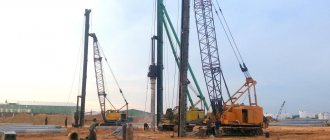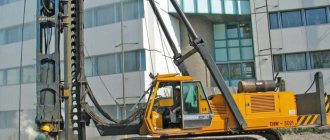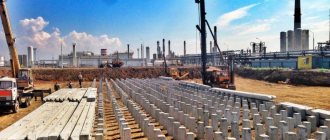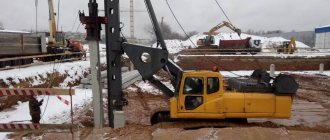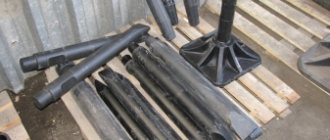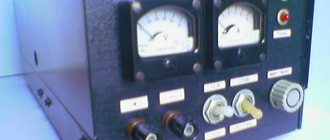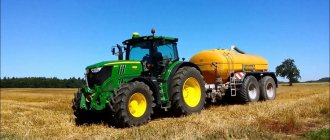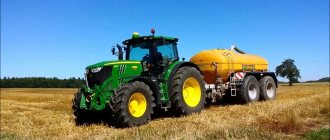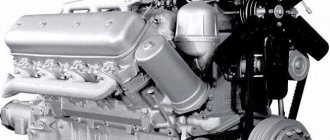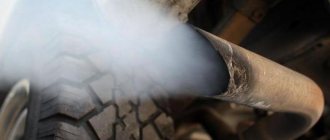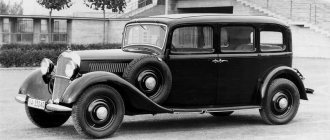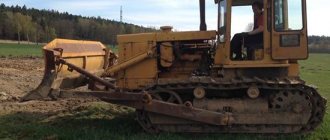Technology for driving piles using a tubular device
The sequence of work performed with this type of unit is as follows:
- the first stage is the joining of the piston part with the cat, after which they are raised to the upper position using a pile driver winch;
- after this, this part and the cat are automatically disconnected, as a result of which the impact part falls along the guide;
- While the falling process is taking place, the pump is switched on and begins to gradually pump diesel fuel into a special recess located in the upper part of the chabot body;
- during the lowering of the piston, the process of air compression also occurs inside the hammer tube;
- when the piston hits the shaft, fuel detonates, during which part of the energy is spent on lifting the hammer back, and the other on driving the pile into the ground.
In other words, the immersion and operation of a diesel hammer occurs due to the impact of impact energy and gas-dynamic energy, which occurs during fuel detonation.
Features of Tubular Type
The tubular diesel hammer differs primarily in that its design is completely unified. The production of this type of unit is carried out according to a long-established scheme. For this reason, any hammer of this type will be no different from any other tubular apparatus. As for its main elements, they are as follows:
- The main equipment for fixation is a “cat”. This device has an automatic mechanism that locks and resets as needed.
- It also consists of a striker. This element is presented in the form of a piston, which is equipped with compression rings.
- The next element of a diesel hammer for driving piles is a chabot. This element is the striking surface, which during operation comes into contact with an element such as the firing pin.
- There is also a working cylinder, inside which fuel detonates during hammer operation.
- Equipment lubrication and cooling systems are provided.
- Guide tube made of high-strength steel.
The main difference between these two types is that the tubular type has a forced water cooling system. This makes it possible to operate the hammer without stopping. While the rod type does not have such a system. Every hour of work should be accompanied by a break so that the structural elements cool naturally.
Features of use
The hydraulic hammer is an attachment and for its operation it requires a wheeled or tracked installation (pilfer) equipped with an external boom. Wheeled pile drivers are made on the basis of all-wheel drive heavy trucks, while tracked ones are based on excavators, tractors or cranes.
When driving steel and reinforced concrete piles, a cap is used to protect the top of the pile from destruction by a hammer; when driving wooden piles, the head of the pile is protected with a cylindrical ring made of strip steel.
The weight and dimensions of the driven piles are determined by three parameters of the pile driver:
- boom lifting capacity;
- usable mast height;
- hydraulic hammer power.
The functionality of the pile driver depends on the presence of a mechanism for adjusting the tilt and reach of the boom. Universal and semi-universal pile drivers allow you to drive piles at an angle; simple pile drivers have a fixed mast.
A hydraulic hammer is a highly loaded mechanism subject to wear. When purchasing or renting a device, the availability of consumables, their price and repair base are important. If the supplier has been on the sales market for a long time, has a service network and highly qualified specialists, then this will be an advantage when choosing.
The process of driving reinforced concrete piles - stages
If we consider the complete process of driving piles, it can be described in several successive stages:
- delivery. Reinforced concrete piles are quite heavy products that need to be brought, unloaded and placed on the construction site in such a way as to minimize their movement during the driving process;
- development of a work plan. Taking into account the location of the pile and the work project, a route for the movement of the pile driver and hammer along the site is developed;
- site preparation. In particular: garbage removal, tree removal, leveling (if required), etc. In some cases, a pit is dug before installing the piles;
- marking the installation site of piles;
- marking the pile. The markings are applied with bright paint in increments of 1000 mm. The presence of marks allows you to control the degree and speed of penetration of the pile into the soil;
- equipment setup;
- driving piles using the selected technology.
Note. During the installation of each pile, the level of its deviation from the vertical axis is monitored. Permissible deviations are contained in the document (“Quality control of the construction of foundations from driven and bored piles”).
Rod type hammer operation
As in the previous case, the work of driving a pile with a hammer of this type takes place in several stages. By the way, the price of a diesel hammer of this type starts from 80 thousand rubles and can reach 1 million rubles or more.
- First, the process of slinging and fixing the pile in the right place takes place. After this, the “cat” is fixed on the winch of the pile driver. Then it goes down and engages with the impact part of the structure.
- The next stage is lifting the cat and the striker to their highest possible position.
- When lifting is completed, the operator activates the release lever. At this moment, the impact part is released and, under its own weight, falls down towards the hinged head, which is fixed to the pile pillar.
- When the firing pin is lowered, the air inside the cylinder is compressed and heated to a temperature of 650 degrees.
- At the moment the hammer hits the hinged head, the pump pumps diesel fuel into the chamber with compressed air.
- During the impact, the fuel spontaneously ignites. The gas that is released at the moment of detonation throws the impact part back upward.
- Naturally, during ascent, the speed will quickly decrease due to the weight of the striker. When the energy is completely exhausted, the part will rush down again. This circular process will continue until the operator switches off the diesel pump.
Operating principle of a pile driving machine
Let us describe the general operating principle of a piling machine, regardless of the type of hammer. The pile driving machine reaches the point. Using his own winch, he pulls the finished pile from the warehouse and brings it to the head of the hammer. After the support takes a vertical position on the point, the machine performs the first few blows. The verticality of the pile is checked and adjusted if necessary. The pile is driven into the ground to the design depth or to the design failure - the minimum amount of immersion in one or several blows on the last meter of immersion. The pile driver moves to the next point. Piles that do not fail as expected may undergo additional driving in a few days.
The operating principle of a piling hammer depends on which technical design is considered.
Design and principle of operation
The design of a diesel hammer includes the following elements:
- piston block;
- shock or working part;
- pump;
- hinged support.
In turn, the impact part also contains additional elements. Its design includes a cylinder, a fuel tank and “cats”.
With the help of the latter, the hammer is suspended on pile ropes. The hammer frame is assembled from guides located in a vertical plane. They are usually connected using a cap at the bottom to ensure structural rigidity. The top of the hammer is considered to be the hammer and moves freely.
The head of the structure contains a piston, due to which the structure moves. The operating principle of a hammer is not as complicated as it might seem. The impact on the headplate occurs after it is possible to raise the cylinder all the way, where the traverse is located, and then sharply lower it. It is worth noting that at the moment of ascent, the air is compressed, due to which the temperature rises. At the same moment, a jet of liquid fuel enters it, which instantly ignites and forms gases, allowing the cylinder to rise sharply.
When the cylinder reaches the traverse and begins to move down, the air in it will begin to compress again. Thus, when the element descends, an explosion will occur again, followed by a repeat of the cycle. This is how the unit works.
With its help, the combustible mixture is released in a timely manner into the cylinder, which is located on the headplate. The mixture enters through a special fuel line, at the end of which there is a nozzle. Pulling the lever causes the injector to move and fuel enters the cylinder. The lever itself is located at the top of the pump structure.
It is noteworthy that the fuel supply process is automated and is carried out directly by the cylinder when it falls down. This result is achieved due to the provided support on the outside.
A device with a hook is placed between the traverse and the cylinder. It holds the cylinder in the required position. The device is fixed by means of a winch cable, due to which the hammer is raised during the installation of the equipment on the pile.
Pros and cons of the design
Despite some differences between tubular and rod devices, they have common positive and negative qualities. The advantages include the following:
- mobility;
- quite simple and very reliable design;
- energy autonomy;
- The productivity of the machines is quite high.
If we talk about shortcomings, there are only three of them. The first is the ground vibration that occurs when struck by a hammer. During operation, a large amount of dust is created, which makes work difficult. In addition, the detonation of diesel fuel releases a certain amount of harmful substances into the atmosphere, thereby polluting it. The price of a tubular diesel hammer starts at a higher amount - from 320 thousand rubles.
The advantage of using a hydraulic hammer
Driving piles can be carried out in several ways: using diesel and hydraulic hammers, pressing, drilling and installing the pile into a well, as well as using a vibratory driver.
The vibrator is effective when working on sand and loose soils; on more complex soils it is necessary to use other equipment. The pressing technology requires high costs for delivering equipment to the work site and, due to the size of the equipment used, is not suitable for small construction sites. Pile driving using leader drilling is used in conditions where, due to geological conditions, driven piles cannot be used.
When comparing a diesel hammer and a hydraulic hammer, most manufacturers choose the latter. And there are reasons for this: if a diesel pile driving hammer hits with almost the same frequency, then the hydraulic drive allows you to change the impact parameters, choosing the mode necessary for a particular soil.
Hydraulic piling equipment is significantly superior to other types of piling equipment in terms of technical and operational parameters, and this explains its growing popularity.
Thus, compared to other types of similar equipment, a hydraulic hammer for driving piles has the following advantages:
- high performance on different soils, reliability;
- ease of operation, no exhaust gases;
- the presence of an effective forced cooling system, which allows you to perform work 24/7;
- the ability to adjust the parameters of the influence on the pile;
- ability to work in cramped conditions;
- minimal seismic impact on the ground;
- long resource.
The performance benefits of a hydraulic hammer are especially noticeable when driving piles under conditions of maximum resistance. On heavy soils, where the use of a diesel hammer is only possible with the help of soil erosion or leader drilling, a hydraulically driven hammer can drive a pile without the use of additional technologies.
Mechanisms for driving driven piles
Piling hammer
Reinforced concrete support pillars for foundations are distinguished by high strength, durability and high technical characteristics (the pile is resistant to torsion and bending), however, the installation of a pile field requires many special mechanisms, including machines for delivering supports to the installation site.
The driving process takes place using special pile hammers, which are transported to the construction site using heavy machines and mechanisms: a crawler crane, a cable and hydraulic excavator. Pile supports up to 10 meters long are driven into the ground by special machines - self-propelled pile driving units, which perform the entire technological cycle of lifting, installing, transporting support elements to the installation site, and directly driving support elements into the ground.
The methods for immersing reinforced concrete support rods into the ground differ significantly due to the use of different technologies.
When driving piles, various equipment is used.
Koper
Pile driver
Pile driver - the principle of driving into the ground using a pile driver consists of delivering a series of blows with a hammer to a separate support set in a certain position. Direct driving is carried out using a hammer, which are classified according to the immersion method:
- Diesel hammer - the operation of this equipment is based on the combustion of diesel fuel. The hammer has an impact part - a special piston with a head, when raised to the highest position, the fuel mixture enters the cylinder. When the hammer falls to the lower position, part of the fuel mixture burns in the cylinder. The energy is directed to the pile, as a result of which the support is progressively driven into the ground, then the process is repeated.
- Hydraulic hammer - this equipment operates on a hydraulic drive, which ensures the movement of the striking part of the hammer up and down. The use of hydraulically driven equipment allows you to monitor the force and frequency of impacts that the hydraulic hammer delivers to a separate support.
It is advisable to construct a pile field near an existing residential building using a hydraulic hammer; this will allow the work to be completed in the most gentle manner possible.
As the pile supports are immersed in the ground as a result of hammer blows, part of the soil is displaced to the surface, the rest of the soil is compacted to the sides and downwards from the pile core. The soil compaction zone around individual supports will extend over a distance equal to 2 to 3 times the diameter of the pile core.
A suitable cap is selected for the hammer, which serves to secure individual supports and protect the upper part of the piles from mechanical damage from contact blows of the hammer.
The cap has an internal cavity, which must ideally match the size and configuration of the pile cap. When the machine is driving pile supports, the head helps to evenly distribute the impact over the entire area of the support element. Watch the video of how Koper KG-12M drives piles:
Vibrator
Vibratory pile driver
Vibratory driver - immersion of individual piles into the ground occurs according to a completely different scheme than when using a piledriver. The machines operate on the principle of creating a vibrating moment along the axis of the pile support. A special device is attached to the head, which consists of a rotator and a weight with a shifted center of gravity. The machine is powered by an electric motor or hydraulic drive.
Machines for installing and driving the pile core create vibration, and under the influence of these forces, the necessary conditions are created for driving the shaft into the ground. The operation of a vibratory driver with a head leads to the summation of vertical forces, which, acting on the pile support, help it sink into the ground, ensuring irreversible destruction of the soil structure.
Installations for pressing piles
Pile pressing installation
Pile-pressing installation - machines operate on the principle of smoothly pressing reinforced concrete pile rods in a certain place into the soil thickness. When dense layers of soil are reached, a series of impacts on the piles can be used to immerse the supports to the design marks.
The technology of pressing piles allows you to carry out work near buildings without causing harm or damage to the structures of existing buildings.
Diagram of a diesel rod hammer
Rice. 3. Diesel hammer type SDM (rod) 1 - piston block; 2— shock part; 3 — guide rods; 4 - fuel tank; 5 - cat; 6 — traverse
The diesel hammer operates automatically, making 50 to 60 blows per minute. The lifting height of the hammer at idle is regulated by the amount of fuel supplied and ranges from 1 to 2 m.
Driving piles with a diesel hammer is carried out in the following sequence.
- The cylinder, raised by the winch to its highest position, becomes unhooked and falls down under its own weight;
- air is compressed
- fuel flares up
- and the cylinder is thrown upward by the resulting gases.
- The gases simultaneously push the piston, increasing the immersion of the pile.
- Having reached the uppermost position, the cylinder falls down again and the hammer operation is automatically repeated until the fuel pump is turned off.
Video of testing a diesel rod hammer
In the considered hammer design, the cylinder is movable and is used as the striking part.
Another design of a diesel hammer has been developed, based on the opposite principle, i.e. the cylinder is stationary, and the impact part is a heavy movable piston. Such hammers are called tubular.
How do you drive piles into the soil?
We found that screw and drilled (drilled) rods do not require the use of large construction equipment. But you won’t be able to immerse the driving rods into the ground yourself. A pile driving machine is used for this purpose. It can be tracked or wheeled.
Tracked vehicles will not be able to simply get to the construction site. To transport it, you will need to order a trawl, and this leads to an increase in the cost of the construction process.
Wheeled vehicles are more mobile in this regard, so their use is more economical.
Pile driving technology
Now we will look at the types of construction equipment that are used to drive reinforced concrete piles into the soil.
They differ fundamentally from each other, primarily in the method of immersion:
1.Pile driver
(industrial scale pile driver). The principle of operation of this installation is to apply a series of blows to a pile installed in the required position. The blows themselves are delivered with a hammer, the types of which can also vary:
2.Vibrator
. A machine for installing and driving a pile core, which works on the principle of creating vibrations along the axis of the pile, is significantly different from a pile driver. The machine is powered by a hydraulic drive or electric motor. The device has a rotator and a weight on which the center of gravity is shifted. It is fixed to the head of the pile, and under the weight of vibration it creates all the conditions for immersion of the rod.
3.Pile pressing installation
. This technique is capable of smoothly pressing reinforced concrete rods into the soil. Only at the final stage of immersion is it possible to apply a series of blows to the rods in order for the rods to reach dense layers of soil. This installation is used in cases where construction is carried out near residential buildings or already constructed structures. It avoids damage to buildings as a result of strong shock vibrations.
Piling works
In practice, pile driving work is carried out in the following order:
- The pile driving machine prepares the reinforced concrete core. To do this, the rod is installed in a position in which it will be immersed. That is, the rod is installed in the head of the device.
- The rod is pressed into the ground until it is possible to press it.
- The rod is struck, thanks to which it is recessed to a given depth.
We can conclude that you can independently make a pile-type foundation using bored or screw piles. Or rent a pile driver and purchase a set of reinforced concrete piles. Using special equipment for driving piles will allow you to build a foundation quite efficiently and quickly, the reliability of which will not have to be doubted.
*We never have low-quality pile foundation projects. We fully monitor and implement all design decisions. Our work fully complies with the requirements of the code of design and construction rules, as well as the rules for designing foundations.
Cost of work
| Works (services) | Dynamic driving (immersion) of a single pile | Static indentation (immersion) of a single pile | Dynamic load testing of piles (one test) | Static load testing of piles (one test) | Relocation of construction equipment | Sheet piling fencing for pits | Installation of bored piles |
| unit | linear meters | linear meters | 1 unit | 1 unit | 1 unit | ||
| cost (RUB) including VAT* | from 260 | from 600 | 10 000 | 65 000 | from 90 000 | negotiable | negotiable |
Unit characteristics
If we consider diesel hammer devices, the tubular type is considered more efficient and also has a more advanced design. If you take a hammer of the same weight, tubular and rod type, and compare their efficiency, you will notice that with the same weight, the tubular design allows you to drive heavier piles. The difference in weight can be up to two or three times greater. The main structural parts of these machines are:
- cylinder or rods;
- the striking part, the striker or the head, which moves inside the cylinder;
- chabot, which is the lower part of the hammer to which the head is attached.
Operating the device
There are spherical recesses on the baba and the chabot, which, when in contact, will form a fuel combustion chamber. Diesel fuel is supplied to this chamber through injection. When a woman hits the chabot, a sufficiently high pressure is created in this chamber, due to which the fuel liquid spontaneously ignites and throws the woman to its highest point. After that she falls back again. In this way, the pile is driven.
If we compare tubular and rod hammers, we can say with confidence that the second type is significantly inferior in terms of service life. The tubular design can last approximately twice as long. Low service life is the main disadvantage of the rod type.
Rod diesel hammer
In Fig. Figure 3 shows a diagram of the design and operation of the SDM diesel rod hammer. It consists of a piston block, a striking part—a cylinder, guide rods, a fuel tank, a cat with which the hammer is suspended on a hummock on the pile driver, and a traverse that determines the position of the hammer relative to the booms of the pile driver. The hammer is installed on the pile using a hinged support.
Inside the frame, consisting of vertical guide rods, which are connected at the bottom by a cap and at the top by a traverse, the striking part of the hammer, which looks like a cylinder open at the bottom, moves freely. The piston is firmly attached to the headplate. The operating principle of a diesel hammer is as follows. If the cylinder is raised up to the traverse and then lowered, then when it falls it will strike the headplate. In this case, the air enclosed in the cylinder will be highly compressed, as a result of which its temperature will increase sharply. At this moment, a stream of atomized liquid fuel (solar oil, diesel fuel, gas oil, etc.) is introduced into the cylinder, which ignites, and the resulting gases throw the cylinder upward to the crosshead.
Then falling down, the cylinder will compress the air again, a new explosion will occur and the cycle will repeat.
The fuel pump, which is an important part of the hammer, as it ensures automatic supply of fuel to the cylinder at the right time, is located on the head and connected to the fuel tank. Fuel enters directly into the cylinder through a fuel line ending with a nozzle mounted in the bottom of the piston. The required portion of fuel is supplied to the cylinder by pressing the lever located at the top of the pump
This operation is performed by a falling cylinder using a special stop located on its outer surface.
Between the cylinder and the upper cross beam there is a special device with a hook for gripping the cylinder. The device is connected to a winch cable, which lifts the entire hammer when installing it on the pile being driven, as well as the cylinder when the hammer is launched.
Main types
First of all, you need to pay attention to the fact that there are several classifications of diesel hammers. It is worth taking a closer look at two of them, as they are the most popular
By type of design
If we consider the classification according to design features, diesel hammers are divided into:
- to tubular;
- rod
The features of these types should be considered separately depending on the selected type.
Rod
The design contains the following elements:
- a piston that stands on a special support;
- vertical guides;
- system for supplying a combustible mixture;
- “cats” that ensure the structure is fixed in the required place.
Upon closer examination of the details, you will notice that the block is a monolithic structure.
It is cast inside the hammer body, and in the block itself, in addition to the piston, there are also compression rings, hoses through which fuel flows, and injectors. The latter are responsible for spraying the mixture into the pump.
The block itself, as already noted, is located on a hinged support. Its lower wall holds vertical guides that ensure the movement of the hammer during the process of driving the pile. To make the structure more rigid, it was decided to connect the guides together with a horizontal crossbar.
When the equipment starts up, the hammer moves along the guides. It moves up and down to drive piles. Additionally, it should be noted that there is a chamber for combustion of fuel liquid at the bottom of the impact housing.
Tubular
The peculiarity of the design of tubular diesel hammers is that it is completely unified and created on the basis of a tractor. In other words, the production of such equipment is carried out according to a proven and established scheme.
Basic design elements.
- "Cats" They are the main equipment for fixing the hammer. The advantage of the device is the presence of an automatic mechanism that ensures timely fixation of the element or its reset.
- Impact piston. Contains compression rings for improved performance.
- Shabota. This is the striking surface that comes into contact with the striker during hammer operation.
- Working part cylinder. It carries out an explosion of the fuel mixture, which ensures the lifting of the hammer.
- Cooling system. Prevents equipment overheating.
- Lubrication system. Provides durability of the structure.
- Guide pipe. It is made of high strength steel.
In this regard, when using equipment of the second type, it becomes necessary to organize regular breaks. This is done so that the structural elements cool naturally. If this is not provided for, the hammer may fail.
By weight
Classification according to the weight of the impact part of the hammer implies the presence of three groups:
- light hammers – up to 600 kg;
- medium hammers – 600-1800 kg;
- heavy hammers - all tools whose mass exceeds 2.5 tons.
The latter are considered the most in demand at any construction site. The former are used for driving small piles in soft soils, as well as for conducting various studies.
Types of diesel hammers for driving piles
The classification of impact equipment used in piling work is carried out based on its design features, according to which diesel hammers of the tubular and rod type are distinguished.
Rod-type structures use two vertical rods as a guiding element for the striking part of the hammer, while tubular units use a fixed pipe.
Piling hammers are also divided into groups based on the mass of the impact part. Hammers with a hammer weight are distinguished:
- up to 0.6 tons - light;
- up to 1.8 tone - medium;
- over 2.5 tons - heavy.
Let's take a closer look at each type of diesel hammer.
1. Rod.
You can see rod-type devices in image 1.1:
Rice. 1.1 : Diesel rod hammer for piling work
The design of a diesel rod hammer consists of the following main elements:
- Piston block mounted on a hinged support;
- Two vertical guide rods;
- Fuel mixture supply system;
- A device for fixing a pile column is a “cat”.
The piston block is a monolithic structure cast inside the hammer body. It includes the piston itself and compression rings, a fuel supply hose, a nozzle for spraying the fuel mixture and a pump that drives it.
The piston block is fixedly fixed on a hinged support, from the bottom wall of which two guide rods extend.
Rice. 1.2 : Diesel rod hammer SP-7
The rods, for more rigid fixation, are connected at the top by a traverse. During operation, the impact part of the hammer moves along the guide rods, on the lower wall of which there is a chamber for combustion of the fuel mixture.
2. Tubular.
Tubular-type structures are shown in Image 1.3.
Rice. 1.3 : Tubular diesel hammers
The structure of all tubular type hammers is completely unified, they are designed according to established standards and have identical design features.
The tubular diesel hammer consists of the following parts:
- “Cats” - for capturing and fastening a pile post, the cat has an automatic locking and releasing mechanism;
- Impact striker - it is represented by a piston equipped with compression rings;
- Chabot - the striking surface with which the striker comes into contact during the operation of the hammer;
- The working cylinder, inside of which there is fuel detonation;
- Lubrication and cooling systems;
- Guide pipe made of high-strength steel.
Rice. 1.4 : Tubular diesel hammer SP-77
Unlike rod-type hammers, tubular structures have a forced water cooling system, which makes it possible to continuously operate these devices, while the operation of rod hammers must include regular breaks after every hour of driving piles, necessary for natural cooling of structural elements.
You can choose the required piling installation yourself in our equipment section.
Models and manufacturers of Russian diesel hammers.
Modern diesel hammers allow high-quality driving of any type of piles in a wide variety of conditions. The main factor in this case is the weight of the hammer itself, since the force of the impacts depends on this, therefore, when marking, the abbreviated name of the type is indicated - rod or tubular and the mass of the impact piston in kg. Thus, all diesel pile driving hammers are abbreviated as MSDS - rod hammers or MSDT - pipe hammers. The main manufacturers of this special equipment in Russia are JSC Stroymash Plant (Sterlitamak, Bashkortostan)
and OJSC "Stroydormash" (Alapaevsk), which produce all basic models, combining them into a series of joint ventures. Each SP hammer is assigned an index indicating its type and purpose, as well as its main characteristics. The higher the index, the more massive piles and in denser soil the diesel hammer can work.
There are models for diesel rod hammers:
- SP-60 - with a shock mass of 240 kg, for piles up to 0.4 tons
- SP-60A - modification of SP-60 with a hammer weight of 250 kg, for piles up to 0.4 tons
- SP-4 - for piles up to 3.2 tons, weight 1250 kg
- SP-5 - 1800 kg, piles up to 3.2 tons
- SP-6V - 2500 kg, piles up to 3.2 tons
- SP-7 - 3000 kg, piles up to 4 tons
- SP-8 - 3500 kg, piles up to 4 tons
For tubular diesel hammers the classification is as follows:
- SP-75A for piles 1.2 - 3 tons
- SP-76A for piles 1.8 - 5 tons
- SP-77A pile weight 2.5 - 6.5 tons
- SP-78A for piles from 3.5 to 8 tons
- SP-79 for piles weighing 5 - 10 tons
Hammers of light, medium and heavy classes are presented here with a mass of impact parts of 1250, 1800, 2500, 3500 and 5000 kg, respectively. In addition, each model has different dimensions, which allows you to work with piles of different heights and thicknesses.
A diesel hammer is a production necessity.
For all possible construction options, diesel hammers are the most profitable alternative to other installations. Purchasing such a unit allows you to avoid many problems and save time. Moreover, the reliability of diesel hammers allows them to be used repeatedly, which will recoup the costs over time. For one-time work, it is more advisable to rent a diesel hammer, choosing the most suitable model.
Overview of driving support technology
The technology for immersing the support in the ground depends on the resistance of the pile head, as well as on its length and cross-sectional dimensions.
And in most cases, pile driving work is based on the following technological methods:
- Immersion under dynamic load (impact). In this case, the force plunging the support into the ground is transferred to the head of the pile by a special tool - a pile driver or a hammer.
- Immersion in the ground under the influence of a static load (indentation). In this case, the plunging force is generated by a press pressing the support into the soil.
- Immersion in the ground under the influence of a static load, loosening and pushing through the support (vibration pressing). In this case, the support moves both in the longitudinal and transverse directions under the influence of force generated by a special tool - a vibration presser. Moreover, the use of a vibration compressor makes it possible to reduce the force immersing the support.
- Immersion of a support by hammering or pressing into a pre-drilled (leader) hole. In this case, you can use both a pile driver and a press.
In short, there are quite a lot of immersion techniques mentioned in SNIP for driving piles, and each technology has its own advantages and disadvantages. And since we are interested specifically in driving supports, then further in the text we will consider only the technology of impact immersion.
Impact Diving: Process Overview
Burying a support into the ground under the influence of a shock load is practiced at construction sites remote from residential areas. After all, this “load” is generated by a multi-ton (weight from 2,000 to 12,000 kilograms) hammer for driving piles, falling onto the pile head from a considerable height.
Moreover, the hammer itself, or rather its striker, is mounted (as an attachment) on a crawler crane or a cable or hydraulic excavator.
The energy (load) transmitted by the hammer to the pile head is calculated using the formula:
E= 0.4Qh
In this case, Q is understood as the mass of the hammer “head,” and h is the height of the hammer’s rise before falling onto the head.
Thus, the more massive the hammer and the higher the lifting height, the greater the energy generated by the pile driving machine.
Technological map for driving piles
The process of hammering a support with an impact is as follows:
- Basic equipment – a crane or an excavator – is delivered to the construction site. After that, an attachment with a hammer is attached to the boom of the apparatus. However, a piledriver can also be an independent device with a self-propelled chassis.
- After setting up the pile driver, the pile is pulled into the working area with cables, placing the head of the support in the guide box of the pile driver.
- After positioning the pile, during which the angle of inclination of the support relative to the zero ground level is determined, the driving process begins, raising and dropping the hammer head from a certain height. Moreover, at the beginning this height is still small, since the first blows should plunge the pile to a shallow depth, at which it is still possible to control the position of the pile relative to the zero ground level using guy wires.
- After partial immersion of the pile and final verification of the position of the support, you can proceed to the “pledges” - a series of 10 blows of maximum force. In this case, the hammer is raised to its maximum height and dropped onto the pile head. After each series of “collaterals” the position of the pile is controlled by a hydraulic level. And the maximum deviation of the support from the perpendicular should not exceed one degree. Otherwise, the pile is removed from the ground and everything starts all over again.
Impact driving of a pile is completed only after reaching a special condition - failure of the support, which prevents further immersion of the pile into the ground.
Advantages and disadvantages of impact diving
The main advantage of impact immersion is the high speed of penetration of the support into the ground. Really powerful hammers drive a pile in a matter of minutes, pushing the supports into the soil at a very decent speed (from 0.7-1 m/min to 5 m/min).
And if the first negative quality can be dealt with by cutting down the destroyed part of the support, then the second drawback cannot be eliminated. In addition, pile drivers generate quite strong vibrations in the ground. Therefore, impact driving should be practiced away from already constructed foundations or utilities.
Tubular diesel hammer
Tubular diesel hammers are available with impact parts weighing from 500 to 2,500 kg. The frequency of blows in them reaches 47-55 per minute.
Tubular diesel hammers use a low-pressure fuel pump, which is used only to meter fuel and supply it to the combustion chamber.
The fuel is sprayed by the impact of the piston head on the spherical cavity of the cylinder heel, where the fuel received from the pump is collected.
The main advantages of tubular hammers compared to rod hammers are:
- the absence of an upper traverse, which eliminates the risk of hammer breakage due to excessive lifting of the striking part, causing an impact on the traverse;
- the presence of a low-pressure pump, more durable and simpler in design and operation; h
- Much better conditions for fuel combustion due to more thorough cleaning of the cylinder from combustion products, carried out by natural ventilation.
Internal combustion hammers also have some disadvantages:
- large dimensions, for example, the length of a tubular diesel hammer with an impact part weighing 2,500 kg reaches 4.5 m, which complicates its operation.
- In addition, diesel hammers require qualified care to avoid operational problems.
In conclusion, it should be said that in very weak soils, diesel hammers do not work well, since the cylinder is thrown up so little that its fall does not provide the air compression necessary for a flammable outbreak in the combustion chamber.
Tubular Diesel Piling Hammers
Tubular diesel piling hammers are highly reliable, economical and have the best ratio of impact energy to the weight of the hammer and impact part.
In Russia, tubular diesel hammers with impact weights of 600 (500), 1250, 1800, 2500, 3500 and 5000 kg are manufactured. Heavier tubular diesel hammers are also manufactured abroad (in Germany, the USA and China). Read more in our article “Heavy piling hammers”
Unlike rod-type hammers, in which the striking part is a cylinder, the striking part of tubular hammers is a movable piston. The hammer cylinder remains in a relatively stationary state during operation and provides a given direction of the reciprocating movement of the striking part, and also serves as the working cylinder of the engine. A hammer of this type has two pistons, an upper shock and a lower one that transmits the blow to the pile - a chabot.
Tubular diesel hammer design
The hammer consists of the following main parts: piston 1, cylinder 37, grapple 27 , guide pipe 29 , hammer 9 , fuel pump 5, oil pump 36 and head
Hammer type MSDT1-1800 (SP76A)
1–piston; 2-ear; 3–fuel tank; 4–filter; 5–fuel pump; 6–catcher ring; 7–compression ring; 8–upper bearing; 9–Shabot; 10–lower bearing; 11–shock absorber ring; 12–shock absorber; 13–bar; 14 – oil line for lubrication of the chabot; 15–drain neck; 16–left grip; 17, 23, 25 – filler neck; 18–water tank; 19–exhaust pipe; 20–bolt; 21–oil tank; 22–oil line for piston lubrication; 24–right grip; 26–platoon stop; 27–cat; 28–locking bolt; 29–guide pipe; 30 – cat guide; 31–plate; 32–reset stop; 33 – cover of the longitudinal groove; 34–ear; 35–lid; 36–oil pump; 37 - cylinder
Working principle of a tubular diesel hammer
Most tubular diesel hammers operate on the principle of impact fuel atomization.
The main working (impact) part of the hammer is the piston, which moves in the cylinder pipe and strikes the hammer that closes the cylinder from below. The chabot transmits the impact of the piston to the pile and is the most loaded part, operating at a significant temperature.
The hammer operates automatically according to a two-stroke engine. As the piston rises, fresh air is drawn into the cylinder. As the piston moves downward, some of the air leaves the cylinder until the piston closes the exhaust ports. The cylinder purge cycle ends.
With further downward movement of the piston, the air in the working cylinder is compressed. At the same time, the piston acts on the pump drive lever, and the pump delivers a certain amount of fuel into the cylinder (to the hammer head). At the end of compression in the cylinder, the air pressure and temperature rise sharply. Air compression creates an initial pressure on the pile, which helps it sink. When the piston hits the shaft, the main immersion of the pile occurs and at the same time fuel is sprayed and begins to burn in the combustion chamber. The resulting gases sharply increase the pressure in the chamber, the piston is thrown up, and the pile receives an additional downward push, increasing its immersion.
As the piston moves upward, the exhaust ports open, exhaust gases escape, and the cylinder purge cycle begins again. Having reached the top of the stroke, the piston falls down again, repeating the cycle until the hammer is stopped.
Hammer operation diagram
1- cat; 2- piston; 3- fuel pump; 4- exhaust pipe; 5- cylinder; 6- chabot;
I – piston lift (start), cylinder purging; II – end of purge, fuel supply; III – end of compression, impact on the shaft, fuel combustion; IV – end of fuel combustion, exhaust, beginning of purge.
The height of the piston stroke depends on the amount of immersion of the pile upon impact and the amount of fuel supplied. When the pile is deeply immersed at the beginning of driving, the piston stroke is the smallest, therefore, if a pile that is too light is driven into soft soil, the hammer may not start even after many starting attempts. In this case, you need to use a lighter hammer model.
Design features of tubular diesel hammers offered by Pile Driving Equipment Plant LLC
- The design of the combustion chamber has the shape of an open torus, which ensures effective mixing of compressed air with fuel and prevents destruction of the impact parts of the hammer.
- The hammer design includes a separate oil pump, which improves the operation of the hammer and increases the service life of the hammer. The oil pump is equipped with a removable handle for forced or preliminary lubrication of the working surfaces of the hammer before starting it.
- The hammer piston rings are made of high-strength cast iron, having high reliability and durability with significantly better anti-friction values compared to steel rings.
At the request of the customer, Pile Driving Equipment Plant LLC carries out additional modifications and improvements to the basic design of a tubular diesel piling hammer, namely: the hammer can be equipped with a forced manual cocking device, an enlarged water cooling tank, a vortex combustion chamber, the hammer heads can be equipped with polyurethane shock absorbers. Hammer heads can have different square and round sections, as well as special heads for Larsen tongues and other modifications.
